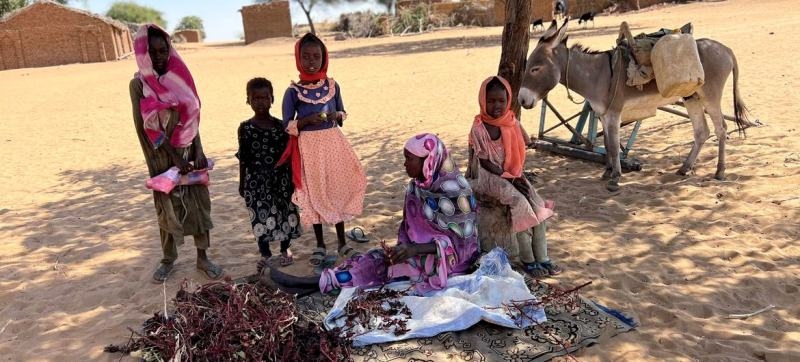- Bangladesh Bank Buys $115 Million to Support Forex Market |
- Tarique Rahman, Daughter Zaima Added to Voter List |
- NCP and LDP Join Jamaat-Led Eight-Party Alliance |
- Tarique Rahman’s gratitude to people for welcoming him on his return |
- Attorney General Md Asaduzzaman resigns to contest election |
Catastrophic hunger doubles in 2024; Gaza, Sudan worst hit

The number of people experiencing extreme hunger has surged in 2024. Pictured here, a displaced family in Sudan. © FAO-Eilaf Abdelbasit
By Vibhu Mishra
5 September 2024 Humanitarian Aid
The number of people experiencing catastrophic hunger has surged more than twofold in 2024, due largely to the ongoing conflicts in Gaza and Sudan, according to new figures released by the UN on Thursday.
The updated Global Report on Food Crises reveals that nearly two million people are now grappling with the most critical level of food insecurity, classified as Phase 5 on the global IPC scale, which tracks acute hunger.
This level represents an “extreme lack of food and exhaustion of coping capacities,” with a sharply increased risk of acute malnutrition and death.
“As well as causing widespread acute malnutrition and death in the short term, it has major human, social and economic impacts in the long term,” the report noted.
The report also found that acute malnutrition among children and women in crisis-affected countries remained “persistently high,” with many families unable to afford a healthy diet.
It also noted that improved harvests helped reduce hunger in several countries, including Kenya, the Democratic Republic of the Congo (DRC), Guatemala, Lebanon and Afghanistan.
The report was prepared by a consortium of UN agencies, including the UN Food and Agriculture Organization (FAO), World Food Programme (WFP), UN Children’s Fund (UNICEF) and the UN International Organization for Migration (IOM), together with humanitarian partners.
Complete collapse in Gaza
Víctor Aguayo, UNICEF Director of Child Nutrition, described the situation for children affected by severe malnutrition.
Briefing journalists at the UN Headquarters in New York, he described the situation in Gaza as one of the most severe food and nutrition crises in history.
“The nutrition situation in Gaza is one of the most severe that we have ever seen…it is important to remember that the nearly half of Gaza’s population suffering from this devastation are children,” he said.
Having returned from the enclave last week, he said that the impact of the war and severe restrictions on humanitarian response have led to a “complete collapse” of food, health and protection systems, with catastrophic consequences.
'No doubt’ that famine is ongoing
“The fact is that the diets of children in Gaza are extremely poor. It is estimated that over 90 per cent of children are eating at best two types of food per day for weeks or months, in the context of very severe…lack of access to safe water and sanitation,” he said.
Estimates suggest that more than 50,000 children need immediate treatment for acute malnutrition, requiring medical professionals and nutrition workers.
“I walked through markets and neighborhoods, or what is left of markets and neighborhoods…there is no doubt in my mind there is a famine and a large-scale nutrition crisis,” he emphasized, calling for an immediate ceasefire and sustained humanitarian access.
Rapid deterioration in Sudan
Máximo Torero, Chief Economist at FAO, highlighted the rapid deterioration of food security in Sudan.
The ongoing conflict between rival militaries and limited humanitarian access have led to famine in some internally displaced people (IDP) camps and risked further spread. The situation is not expected improve at least until October.
“The conflict continues to drive a rapid deterioration of food security, with about 26 per cent more people estimated to face high levels of acute food insecurity during the June to September lead period compared to June last year, reaching 25.6 million people classified in crisis or worse,” he stated.
This crisis also affects neighbouring countries, including Chad and South Sudan, which are hosting a large number of Sudanese refugees while dealing with their own conflict- and climate-induced crises, he added.
Access and funding
Arif Husain, WFP Chief Economist, underscored the growing global burden of food crises, rising from 90 million people in 2023 to an estimated 99 million this year.
He emphasized the need for both access and funding to address the crisis effectively.
The first is access – physical access to people in need, safe and sustained access,” he said, adding “the second is funding to provide assistance in a sustained manner, until the time there is.”
“If you have one, it is not enough. If you have only access or if you have only money, that is not enough. You need both,” he stressed.
Address root causes
Mr. Husain also underscored the need to address the root causes that are driving hunger and malnutrition.
“Whether it is war or whether it is climate, unless we address the root causes, we must not expect the needs to come down,” he said.
In conclusion, he said that while experts and humanitarians know about the situations noted in the report, there are many other hotspots in similar circumstances, but where little information or data is available, such as in Zambia.
“But we cannot say that there is a famine there because we have no data. So access – to get the information – is also critical.” - UN News

